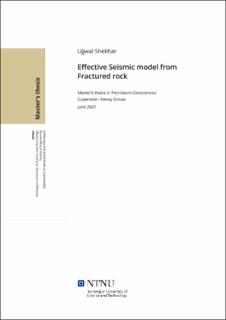| dc.description.abstract | Analyses of vertical fractures are of great interest in characterizing the fluid flow and minimum in situ stress direction in reservoirs. Fractures are responsible for permeability anisotropy in a reservoir. Fractures can be the cause of migration of hydrocarbons, leakage of drilling fluid and even release of gases like methane on seabed. There is a need to extensively study the small-scale fractures, embedded in host rock to understand the challenges in exploitation of fractured reservoirs. Nowadays, technologies for carbon capture and storage (CCS) are gaining popularity. CCS involves massive injection of carbon dioxide into the subsurface, thereby altering the stress state in the reservoir. Fractures play a vital role in the mobilization of CO2. Knowledge about fracture systems in the subsurface formation can help estimate a threshold value of volume to be injected. This may prevent leakage of gas to atmosphere in case of onshore reservoir or into the ocean water for offshore reservoir and potential seismic hazard induced by injection activities. Presence of small scale fractures can be detected in the drilled cores. However, this gives us information about fractures over a very small area only. By using seismic attributes, we get such information on a broader scale. The importance of this work may be realized by considering the cost involved in drilling a borehole. It is to be noted that tremendous amount of seismic data acquired over some of the major fractured reservoirs in the world are already available. And the expressions for numerical computation of seismic attributes using fracture parameters are straightforward and simple.
Long-wavelength equivalent orthorhombic (ORT) media and monoclinic media typically characterize the anisotropy induced by a set (or two sets orthogonal to each other) of vertical parallel fractures and two non-orthogonal sets of vertical fractures respectively, embedded into a transversely isotropic medium with a vertical symmetry axis (VTI). In nature, transverse isotropy is usually displayed by sedimentary rocks, planar igneous bodies and floating ice sheets. The equivalent stiffness matrix for the Vertically Fractured media with Transverse Isotropy (VFTI) and monoclinic media are derived from the background stiffness coefficients and fracture weaknesses parameters. The goal of this thesis work is to accurately model fractures and analyze the fracture response in normal move-out velocities (defined by traveltimes) and gradient term in the reflection coefficient of the amplitude vs azimuth attributes for different wave modes. These responses are based on changes in the orientation of fracture sets and the magnitude of fracture weaknesses. These seismic data, acquired over a fractured reservoir can also be inverted for the azimuth angles of fracture sets present in the host rock.
In the first part, study has been carried upon VFTI media. A term called eccentricity of the normal move-out (NMO) velocities ellipse is defined. We will see the sensitivities towards fracture weaknesses in the eccentricity term for pure wave modes (PP, S1S1, S2S2) and converted wave modes (PS1, PS2, S1S2). Similar study on amplitude vs azimuth (AVAz) analyses of fractured media is done. Sensitivities towards fracture weaknesses in the gradient term of reflection coefficients for pure wave modes (PP, SVSV, SHSH) and converted wave modes (PSV, PSH and SVSH) are determined.
In the second part, fracture response in NMO velocities and gradient term in the reflection coefficient of AVAz attributes for different wave modes are observed for monoclinic media. Inverse modeling study that aims to determine the orientation of fracture systems from the given seismic data has been carried out. The error in azimuth angle of fracture sets for such inversion technique has been calculated.
Finally, sensitivities towards fracture parameters established from both attributes are compared. The advantages and limitations of both data sets are then discussed. Apart from a standard model, the study has also been carried upon two arbitrary models, the VTI background medium of which are derived from upscaling of well log data. Generalized conclusions about the applicability of results so obtained have been made. | |
